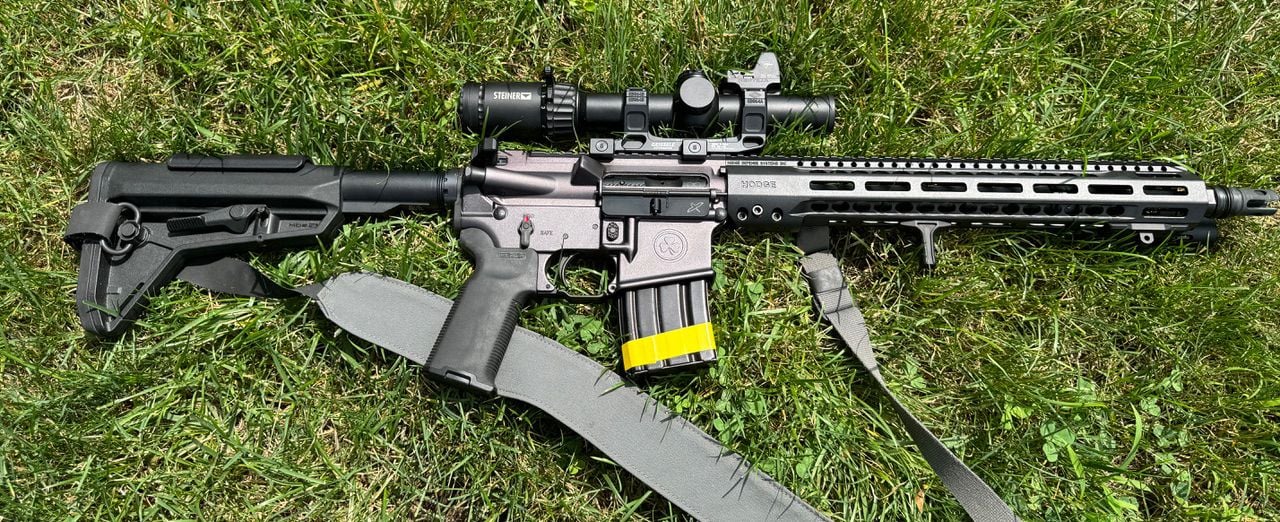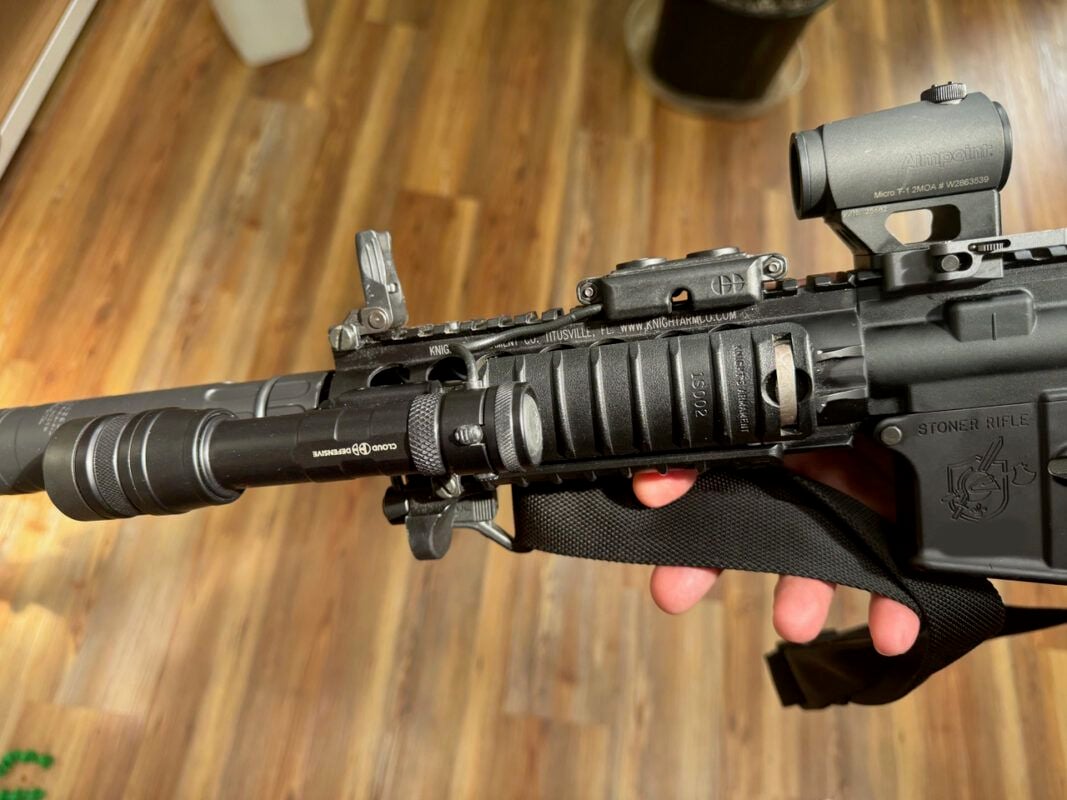AR-15 Accessories, AR-15 Basics
Understanding AR-15 Barrel Lengths: From 7.5″ to 20″
When it comes to the AR-15 platform, one of the most crucial decisions you’ll make is choosing the right barrel length. The AR-15 barrel length you select can significantly impact everything from accuracy to maneuverability, so it’s important to understand the role it plays. AR-15 barrels come in a variety of lengths, from ultra-short 7.5-inch barrels to long 20-inch options, each with its own set of advantages and trade-offs.
In this guide, we’ll explore the history of AR-15 barrel lengths, discuss the key factors you should consider, and explain why a 16-inch barrel is often seen as the ideal length for most shooters. By the end, you’ll have a clearer picture of what length suits your needs based on how you plan to use your AR-15.
If you want to get right to the point, though, for many of you, the decision largely comes down to one key question: Do you want to go the route of building an SBR (Short-Barreled Rifle) or stick with a standard rifle? If you’re planning on an SBR build, and you’re set on using 5.56, we’d recommend going with a 12.5-inch barrel and calling it a day. Anything shorter and you’ll be sacrificing too much velocity with 5.56, so in that case, we’d suggest moving to a .300 Blackout SBR with an 8-inch barrel for optimal performance. However, for most of our builds, we’ve refocused on using the standard 16-inch 5.56 barrel, which strikes the perfect balance between performance, legality, and versatility.

The History of AR-15 Barrel Lengths
The AR-15 was originally designed by Eugene Stoner in the late 1950s, with the intention of providing a lightweight, accurate, and reliable rifle for military use. The original AR-15 came equipped with a 20-inch barrel, which was ideal for achieving maximum velocity with 5.56 NATO rounds. This barrel length allowed the rifle to perform well at extended ranges, delivering high accuracy and ballistic performance.
However, as the AR platform evolved and its use expanded beyond military applications, different barrel lengths were developed to cater to various roles, including close-quarters combat and civilian use. Today, AR-15s come in a wide range of barrel lengths, each suited to specific tasks, environments, and preferences.

Why Barrel Length Matters
Barrel length affects several critical aspects of your AR-15’s performance:
- Velocity and Accuracy: The longer the barrel, the more time the bullet has to accelerate before leaving the muzzle. This translates into higher velocity and better long-range accuracy. Shorter barrels reduce velocity, which can negatively impact accuracy over longer distances.
- Maneuverability: Shorter barrels are lighter and more maneuverable, making them ideal for close-quarters scenarios like home defense or tactical operations. However, this comes at the cost of velocity and effective range.
- Recoil and Blast: Longer barrels tend to soften recoil and reduce the muzzle blast, making shooting more comfortable, especially with higher-velocity rounds. Shorter barrels, especially those under 10.5 inches, can create substantial muzzle blast, noise, and recoil.

Common AR-15 Barrel Lengths
Let’s break down the most common AR-15 barrel lengths, their uses, and why you might choose one over another.
18 to 20 Inches: Classic Performance for Distance
Barrels in the 18 to 20-inch range fall under what is typically known as rifle-length configurations. These longer barrels allow the AR-15 to achieve maximum velocity with standard 5.56 NATO or .223 Remington rounds, making them ideal for long-range precision shooting. As mentioned earlier, the original AR-15 was built with a 20-inch barrel to optimize ballistic performance. With a longer barrel, bullets are given more time to accelerate, which results in higher muzzle velocity and improved accuracy at extended ranges.
For shooters focused on maximizing the potential of their ammunition—whether for target shooting, varmint hunting, or competition—a longer barrel makes sense. It allows the rifle to fully harness the capabilities of the round, particularly in terms of trajectory and terminal ballistics. Cartridges like the .224 Valkyrie, 6.5 Grendel, and 6mm ARC especially benefit from 18 to 20-inch barrels, which provide the necessary velocity for their ballistic profiles at longer ranges.
That said, the trade-off with these longer barrels is reduced maneuverability. A 20-inch rifle can feel bulky in confined spaces, making it less practical for home defense or close-quarters applications. However, if long-range accuracy is your primary goal, the added weight and length are minor drawbacks compared to the performance gains.
16 Inches: The Versatile Standard
The 16-inch barrel length has become the de facto standard for AR-15 rifles, primarily because it offers a balance between performance and convenience. In the U.S., the legal limit for a rifle barrel is 16 inches; anything shorter requires a special tax stamp and registration as a short-barreled rifle (SBR). For this reason, 16 inches has become the go-to length for most civilian AR-15 users.

But legality aside, a 16-inch barrel still offers plenty of practical advantages. It provides enough length to achieve a decent muzzle velocity with 5.56 NATO rounds while being short enough to maintain good maneuverability. This makes it a highly versatile option for those looking for a rifle that can do a bit of everything—whether it’s home defense, range shooting, or even light hunting.
Moreover, the advent of mid-length gas systems for 16-inch barrels has made them even more attractive. These systems offer softer recoil and a smoother shooting experience compared to older carbine-length gas systems. In essence, the 16-inch barrel strikes an ideal middle ground, making it one of the most popular choices among AR-15 owners.
13.7 to 14.5 Inches: Shorter, Lighter, and Still Legal AR-15 Barrels
If you want the maneuverability of a shorter barrel without navigating SBR laws, 13.7-inch to 14.5-inch barrels paired with pinned and welded muzzle devices are a popular option. These muzzle devices extend the overall length of the barrel to meet the 16-inch legal requirement, but the actual rifled portion of the barrel remains shorter.

A pinned and welded barrel can provide a noticeable reduction in weight and increase maneuverability compared to a standard 16-inch setup. For example, a 14.5-inch barrel paired with a suppressor-ready muzzle device makes the rifle shorter without sacrificing too much ballistic performance. Basically, you don’t feel like you’re wielding a musket. That said, the process of pinning and welding a muzzle device means that it cannot easily be changed later, so users should be confident in their setup before making this decision.

10.5 to 12.5 Inches: Close-Quarters Specialists
Barrels in the 10.5 to 12.5-inch range are where we start entering the realm of short-barreled rifles (SBRs) and AR-15 pistols. These shorter barrels are ideal for close-quarters combat (CQB), home defense, and tactical environments where maneuverability is a priority. You’ll often see military and law enforcement personnel using AR-15s with 10.3-inch or 11.5-inch barrels for this very reason, particularly in urban operations.

Short barrels like these excel in confined spaces, making it easier to navigate hallways or vehicles. However, this comes at the cost of reduced muzzle velocity. With a 10.5-inch barrel, the 5.56 round loses a significant amount of velocity, impacting both effective range and terminal ballistics. Still, for distances of 100 yards or less, they perform adequately.
To mitigate the loss of velocity, many users turn to .300 Blackout. This cartridge was specifically designed to work efficiently in short barrels, and it shines in this range when paired with a suppressor. Subsonic .300 Blackout loads are particularly effective in home defense scenarios due to their quiet report when suppressed, making these barrels an excellent choice for tactical setups.
7.5 to 10 Inches: An Ultra-Compact and Specialized AR-15 Barrel
Barrels under 10 inches are on the extreme end of compactness for AR-15s. These are the shortest configurations available, often used in AR-15 pistols or SBRs that prioritize mobility above all else. A 7.5-inch AR-15 looks more like a submachine gun than a traditional rifle, and while it may offer unparalleled maneuverability, the trade-offs are significant.

With such short barrels, 5.56 NATO rounds lose so much velocity that their effective range and terminal performance are severely compromised. The muzzle blast, recoil, and flash are also far more intense than with longer barrels, which can make shooting uncomfortable. These ultra-short barrels are best reserved for specialized roles or for calibers designed to perform in shorter lengths—like .300 Blackout.

Understanding the Trade-offs
As you can see, every barrel length offers different trade-offs, from velocity to recoil to maneuverability. It’s important to consider the primary purpose of your AR-15 when choosing the right length. If you’re building a rifle for long-range precision, stick to an 18 to 20-inch barrel. If you’re focused on general-purpose shooting and want something versatile, a 16-inch barrel is probably your best bet. For close-quarters, an SBR or AR pistol with a barrel between 10.5 to 12.5 inches will serve you well, especially when paired with a .300 Blackout round.
Final Thoughts on Barrel Length
Ultimately, your choice comes down to whether you want to go the SBR route or stick with a standard rifle. If you’re committed to 5.56 and building an SBR, a 12.5-inch barrel is ideal, but any shorter and we’d advise switching to .300 Blackout. However, for most of our builds, we’ve focused on the 16-inch barrel in 5.56 for its all-around versatility. It provides the right balance of velocity, accuracy, and maneuverability, without requiring the additional hassle of dealing with SBR paperwork.
In short, there is no single “best” AR-15 barrel length, but rather the best length for your intended purpose. Whether it’s long-range accuracy, close-quarters combat, or general-purpose shooting, there’s an AR-15 barrel length that’s right for you. The modularity of the AR platform also means you can always switch out components as your needs evolve, giving you the flexibility to experiment with different barrel lengths over time.

